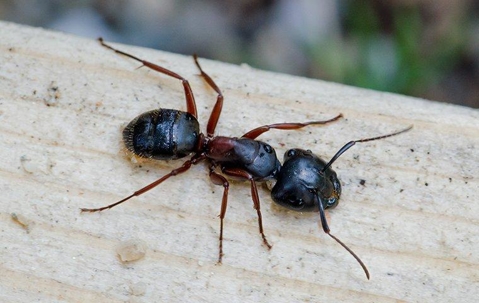Black dots swarming around your eyes? Either you need to see an ophthalmologist, or your house has one of the most common pests in Illinois and Iowa: ants.
They might be tiny and nonthreatening, but ants are certainly not the most innocent insects out there. For residents in and around Moline, Illinois, here’s your handy guide to tell if the ants around your property pose a threat to your household.
All About Ants
Like many insects, there’s no singular ant species. There are thousands of ant types around the world, with many of those species existing right here in Central Illinois. While no two ants are alike, many share similar characteristics.
All ants have segmented bodies split into three sections: a head, a thorax, and an abdomen. On top of the head are two antennae of varying lengths; the thorax, or mid-section, has six legs protruding off of it; and the abdomen is the large, rounded back end with a stinger that’s dull or sharp, depending on the species. Ants vary in color: most are black, brown, or dark red, though occasionally an ant will have a striped abdomen. While ants can grow as large as 3-4 cm, they can also stay as small as 2 mm. Most measure around ¼ of an inch.
Most ants are considered nuisance pests, meaning they don’t bring much harm to people, they’re just annoying to have in the house and obnoxious to get rid of. However, all ants can contaminate food and spread diseases around the house, so don’t take an infestation lightly.
Dangerous Ants in Moline
There are two species of ants which, on top of contaminating food sources and possibly spreading disease, bring additional problems to households they infest. Carpenter ants and pharaoh ants could wreak havoc on your Illinois property, unless you identify and exterminate them fast.
Carpenter ants, on average, grow to about a half an inch, and their bodies range from yellow to red to black. They can be distinguished from other species based on their single-node waist, their rounded thorax, and their large mandibles (mouths). These ants can cause serious home damage over time. Carpenter ants are primarily attracted to water-damaged wood, and they will make their way into your home to move near any food source, and then eat through your home's infrastructure (given enough time). Home damage caused by their tunnels can cause serious safety issues, not to mention the loss of property value.
Pharaoh ants, by contrast, are one of the smallest ant species in the world. The average worker grows to only 1/16 of an inch, and their small size and pale yellow bodies makes them nuisances in even the tiniest of spaces. Pharaoh ants are pests because they crowd around any food source they can find, spreading harmful bacteria through your pantry. Further, their small size makes them near impossible to get rid of on your own. Finally, disrupting the colony usually makes it spread. Pharaoh ants are like the hydra head, if you kill one you create two.
Invasive Ant Prevention Tips
Depending on the ant species and where they tend to forage, ants can spread diseases like E. coli, shigella, and salmonella. The best way to avoid these diseases is to stop an infestation before it starts. Consider the following:
- Remove all potential food sources from outside the house. Keep trash cans indoors or lock them securely; otherwise, ants will colonize near your house and might sense that there’s food inside.
- Inspect and close any cracks around your home, including in the windowsills, door frames, vents, and crawl spaces.
- For carpenter ants, make sure there isn’t any water-damaged wood around your house, including woodpiles outdoors or in crawl spaces.
Ants are everywhere, and they’re often essential to the ecosystem, so if one or two gets in your house, don’t worry. But if they keep popping up from somewhere, it’s time to bring in the experts over at Quik-Kill Pest Eliminators. Call us today!

